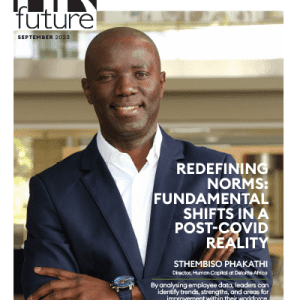Follow these two key paths to achieving sustainable employee engagement in the digital economy.
The majority of global businesses are going through significant changes in order to stay relevant in a digital world that thrives on disruptive innovations and is mulishly unwilling to bond with the conventional notions of management.
This has profound implications for progressive organisations that are adamantly focused on retaining desired talent. The respective task is made harder by the presence of a diverse and multigenerational workforce with different aspirations and motivations. Generally, in their desperation, the majority of corporate entities resort to sweetening the Employee Value Proposition (EVP) by offering a one-size-fits-all package without doing an exhaustive study of the ‘ambition’ drivers for each major sect of employees.
This is exacerbated by the fact that very little real effort is made by decision-makers to reach out to employees for including their voice in framing the policies/procedures/processes that are more conducive to a healthy working relationship. Interestingly, technology seems to be a key protagonist of such isolationism since it provides a relationship buffer in maintaining the mirage of organisational harmony by ensuring prime focus on efficiency, rather than delving deeply into the intricacies of sound employee relationships.
With the days of company loyalty long gone, the focus is increasingly on a mutually beneficial partnership where both parties, the employer and the employee, align their priorities for a reasonable amount of time under the affirmation of a win-win resolution. This is buoyed by a psychological contract that has also shifted from being blindly based on solemn faith to being watchfully propped up on validated trust. Consequently, employee engagement is also gravitating towards a more purpose-driven display of altruistic professionalism from the more recognisable affective manifestation of organisational citizenship behaviour.
Interestingly, most progressive organisations tend to start requiring employee engagement, rather than, expecting it as a natural offshoot of an enterprising culture based upon robust values. This has the downside of becoming a job specification which brings shrewd actors into play who are enticed by the external motivation of gaining associated rewards and recognition. Consequently, the glamourisation of employee engagement often eclipses the voluntary initiatives of truly engaged employees who are driven by the primary intrinsic motivation of doing good as an affirmation of their exemplary professionalism.
It is the resilience and character of the truly engaged employees that is the best hope for an organisation to survive business upheavals in precarious economic conditions. This requires the presence of a conducive work environment that ensures sustainable employee engagement instead of just achieving employee engagement since it is not a resolutely fixed destination, rather, an undulating enchanting journey taken to imbue new experiences under a higher calling. There are two main paths to achieving sustainable employee engagement in the digital economy.
They are:

PATH I (Aspiration-focused)
This is dutifully adopted by corporate entities that feel burdened with the expectations of the key stakeholders and want to ensure smooth running of all operations to assure the going concern status of their organisation. Performance expectations are clearly defined and KRAs/KPIs are extravagantly used to monitor and improve any lagging parameters from desired standards. Reward and recognition elements are astutely used to mask any simmering signs of discontent.
Policies/procedures/processes/ systems are designed for resource optimisation and workplace harmony. Informal/formal feedback is taken periodically to proactively deal with any aspects that may disrupt the disciplined stride towards achieving targeted goals. Employees are considered valuable assets; however, their usefulness is contingent upon the rate of associated depreciation, especially, in view of technological advances. Consequently, High-Potentials are assiduously sorted out of the talent pool and given prime attention with the expectation that they will also be the role models for employee engagement initiatives. Let’s take a brief look at each of the constituent steps to gain a better appreciation for going down the respective path.
Recruitment and Selection (Merit-Based)
This refers to the normative practice of hiring desired talent according to clearly defined criteria that are designed to preclude any form of exclusion/discrimination and meet applicable legal regulations and corporate mandates. Primarily led by the HR/Talent Management function with necessary inputs/facilitation from all the other key stakeholders.
Employee Orientation (Relevance-Based)
This refers to all the activities that are undertaken to ensure that the inducted employees are fully cognisant of key policies/procedures/processes applicable to them. It also sets the foundation for the relevant functional heads to guide their assigned staff in becoming valuable members of the team with clear understanding of the job expectations.
Performance Management (Competency-Based)
This type of performance management is rooted in identifying, monitoring, improving and sustaining the desired competencies within the workforce. It ensures that the organisation is never starved of the necessary behaviours, skills and knowledge needed to compete in an unforgiving market.
Reward and Recognition (Requirement-Based)
This type of Reward and Recognition is derived from the fulfilment of certain requirements that are laid out in advance to all the key stakeholders. This can range from a conventional salary package to the integrated application of total rewards that runs concurrently with the employee lifecycle. It can also be astutely used as golden handcuffs to retain desired talent.
Focused Training and Progressive Development
This refers to readying and grooming of the budding talent through a targeted regimen of skills and knowledge that are deemed necessary as a result of shortcomings realised after performance appraisals or in management reviews due to any changes in the organisational functionality. The associated developmental process is incremented in accordance with the level of skill achieved.
High-Potential Recognition (Criteria-Based)
This refers to identifying the talent who have excelled in their current roles in accordance with explicitly defined parameters and are deemed suitable for leadership positions in future. They are considered the ‘prized assets’ and garner prime attention of the senior management. It remains a matter of debate whether such status should be kept confidential or conveyed openly.
Employee Entitlement (Status-Based)
This refers to the psychological mindset of High-Potentials as they are made aware formally or pick up hints from their supervisor/functional head of their special status within the workforce. On one hand, it can engender positive feelings of accomplishment, gratitude, motivation, etc., while on the other, increase narcissism, class warfare with peers, privilege claims, etc.
Augmented Activities (Gain-Based)
This refers to the type of extrinsic motivation tools that are deployed by the senior management to tighten the ‘golden handcuffs’ on High-Potentials in order to ensure retention while negating any attempts by opportunistic competitors to wrestle them away. These can include higher bonuses, surprise holiday privileges, free memberships and socialisation with senior leaders.
Employee Engagement (Attitude-Based)
This type of employee engagement is driven by intrinsic motivation and hard to paint as an organisational norm. Generally, it is a reflection of an individual’s inherent attributes and, quite possibly, a result of his/her own success in overcoming serious challenges and achieving significant success, e.g., becoming a High-Potential, that incentivises them to pay it forward.
Leadership Development (Need-Based)
This type of leadership development is initiated in accordance to the apparent demand for capable leaders to take the mantle from those exiting the organisation. It is reactive in nature since the number of leaders leaving is largely known and within predictable limits. Necessary arrangements are made to ensure a smooth transition with minimal disturbance to operations.
Succession Management (Position-Based)
This type of succession management is done by focusing on critical leadership positions within the organisational hierarchy. Care is taken to ensure that there are no ambiguities in qualifications that need to be met to ensure a timely and suitable successor for the departing leaders. Vacancies are sometimes split into two to avoid talent loss and facilitate closer focus.
Sustainable Employee Engagement (Foreseeable Future)
This refers to ensuring sustainable employee engagement within the predictable business cycle by keeping the High-Potentials motivated through timely and relevant leadership development and succession management initiatives. It involves keeping a close watch over their wellbeing and being reasonably accommodative to any fluctuation in professional expectations.
Murad Salman Mirza is a Committed Organisational Architect, Positive Change Driver, Unrepentant Success Addict and a globally published author based in the United Arab Emirates.
This article appeared in the April 2016 issue of HR Future magazine.
Click here for Path II.














